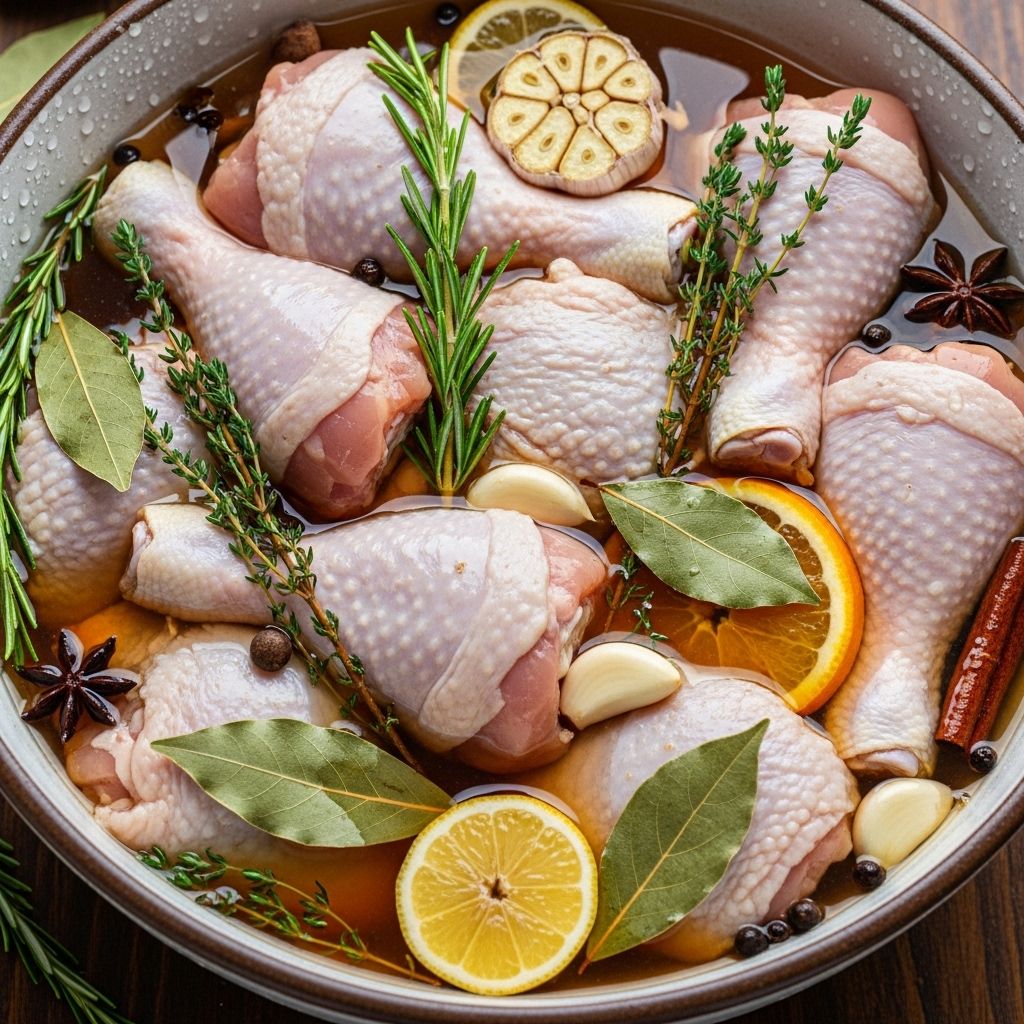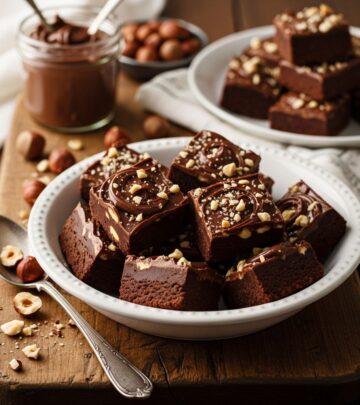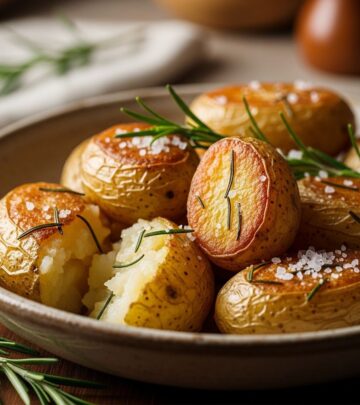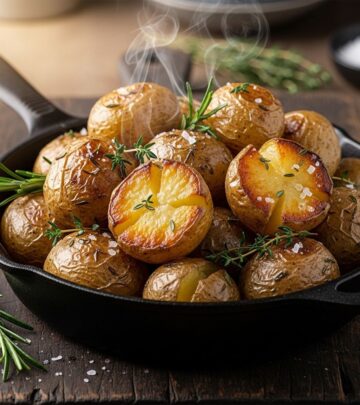Chicken Brine Recipe: 6 Steps For Juicy, Flavorful Chicken
Master the art of chicken brining for juicy, flavorful results every time with this essential guide.

Image: HearthJunction Design Team
Perfect Chicken Brine: The Ultimate Flavor Boost for Juicy Chicken
Brining is a time-honored technique that elevates chicken from dry and flavorless to moist, tender, and irresistible. With the right brine, you not only season the meat deeply but also ensure that every bite bursts with deliciousness. In this comprehensive guide, you’ll discover the perfect chicken brine recipe, detailed instructions for brining, helpful tips, and answers to frequently asked questions to guarantee success in your kitchen every time.
Why Brine Chicken?
Brining is the process of soaking poultry in a salted liquid solution. It works by allowing the salt to alter the chicken’s protein structure, enabling it to retain more moisture during cooking. The addition of aromatics and herbs infuses the chicken with subtle flavors that standard seasoning just can’t achieve. The result? Chicken that is juicier, more tender, and packed with flavor.
- Moisture retention: Prevents dry, overcooked chicken by locking in juices.
- Deep seasoning: Salt and aromatics penetrate beyond the surface, seasoning the chicken throughout.
- Flavor enhancement: Herbs, spices, and other additions boost the chicken’s natural taste.
Ingredients for the Perfect Chicken Brine
This classic brine strikes a perfect balance between salt, sugar, and aromatic herbs. The following measurements yield enough brine for up to 16 servings:
- 16 cups (1 gallon) water
- 3/4 cup kosher salt
- 2/3 cup white sugar
- 1/4 cup dried sage (or to taste)
- 1/4 cup dried basil (or to taste)
- 2 heads garlic, crushed and chopped
- 1 tablespoon whole black peppercorns
- 1 large bay leaf
All ingredients are essential for producing a balanced brine that delivers a nuanced herbal flavor while keeping the chicken juicy and satisfying.
Step-by-Step Directions
- Combine ingredients: In a large pot, mix water, kosher salt, sugar, sage, basil, garlic, peppercorns, and bay leaf.
- Simmer: Bring the mixture to a gentle simmer over medium-high heat, stirring occasionally. Cook for 20-30 minutes, or until the salt and sugar have fully dissolved.
- Steep the herbs: Remove the pot from heat, cover with a lid, and let the brine sit at room temperature for 2 hours. This allows the dried herbs to steep, releasing their full flavor into the brine.
- Chill: Refrigerate the brine for at least 1 hour, or until completely cool. Never use a warm brine on raw chicken, as it can lead to food safety issues and begin cooking the meat prematurely.
- Brine your chicken: Submerge chicken pieces or whole chickens in the chilled brine, cover, and refrigerate for several hours or overnight — ideally 8 to 12 hours, depending on size.
- Rinse and prepare: Before cooking, remove the chicken from the brine, rinse thoroughly with cold water to remove excess salt, and pat dry with paper towels. Proceed with your preferred cooking method.
Pro Tips & Tricks
- Use kosher salt only: Table salt is denser and can result in an overly salty brine. Stick to kosher salt for reliable results.
- Flavor variations: Try adding fresh herbs, citrus zest, juniper berries, or a splash of apple cider for unique twists.
- Brining time: Brine larger cuts (like whole chickens) for 8-12 hours; brine smaller cuts (like breasts, tenders, or thighs) for 1-3 hours.
- Keep it cold: Always brine chicken in the refrigerator to prevent bacterial growth.
- Don’t skip the rinse: Rinse the chicken after brining to remove excess salt and herbs for a balanced flavor.
- Pat dry: Thoroughly pat the chicken dry to ensure crispy skin when roasting or grilling.
Nutrition Information
While the full amount of salt and sugar is calculated for nutritional values, most is left in the brine and not actually consumed. The brining process ensures seasoning without overwhelming sodium or sugar in the final dish.
Brine Variations: Simple and Creative Options
Once you’ve mastered the basic recipe, don’t hesitate to experiment. Here are a few alternative brines:
- Simple Brine: Water, kosher salt, sugar, and a touch of olive oil. Perfect for quick brining when you want classic, clean flavors.
- Brown Sugar Brine: Swap out white sugar for light brown sugar and add molasses for extra depth. A pinch of cayenne and minced garlic add subtle heat and savory notes.
- Pickle Brine Chicken: Repurpose pickle juice with brown sugar, kosher salt, black pepper, and a pinch of cayenne for a tangy, zesty brine. Perfect when you want a punch of flavor and a moist texture.
Sample Brine Comparison Table
| Brine Type | Main Ingredients | Flavor Profile | Ideal Use |
|---|---|---|---|
| Classic Herb Brine | Water, kosher salt, sugar, sage, basil, garlic, peppercorns, bay leaf | Herbaceous, savory | Whole chicken, roasts |
| Simple Brine | Water, kosher salt, sugar, olive oil | Clean, slightly sweet | Chicken breasts, quick brine |
| Brown Sugar Brine | Water, kosher salt, brown sugar, molasses, cayenne, garlic | Sweet, subtly spicy | Grilled or smoked chicken |
| Pickle Brine | Dill pickle juice, brown sugar, kosher salt, pepper, cayenne | Tangy, sharp, peppery | Fried or grilled tenders |
Serving and Cooking Suggestions
- Roasting: After brining and patting dry, roast the chicken at 425°F (218°C) for crispy, golden skin.
- Grilling: Brined chicken stays juicy even over strong heat. Grill over medium-high, turning as needed for even browning.
- Smoking: Brined chicken absorbs additional smoke flavor and remains tender after hours in the smoker.
- Frying: For classic fried chicken, brining ensures each piece is juicy beneath a crackling crust.
No matter how you cook it, brined chicken is less prone to dryness, tough texture, or blandness.
Storage and Make-Ahead Tips
- Prep ahead: Make the brine up to 3 days in advance. Keep it refrigerated in a tightly sealed container until ready to use.
- Storing brined chicken: After removing from brine, chicken can be kept in the refrigerator up to 24 hours before cooking.
- Leftover cooked chicken: Store any cooked, brined chicken in an airtight container in the fridge for up to 4 days.
Frequently Asked Questions (FAQs)
Can I brine frozen chicken?
Yes, you can brine frozen chicken. The chicken will thaw as it brines, making the process efficient. However, extend brining time by 1-2 hours for best results.
How long should I brine chicken?
Brining time varies by size of the chicken pieces. Whole chickens benefit from 8-12 hours in brine, while breasts, thighs, or tenders typically require 1-3 hours. Avoid over-brining, as it can result in a mushy texture or overly salty flavor.
Is it safe to reuse brine?
No. Always discard used brine after removing the chicken, as it has been in contact with raw poultry and may harbor bacteria.
What if I don’t have all the herbs listed?
Feel free to customize the brine with your favorite dried or fresh herbs, or use what you have on hand. Rosemary, thyme, or oregano all work well. The recipe is flexible and adapts to your pantry.
Does brined chicken taste salty?
If the chicken is brined for the recommended time and rinsed well before cooking, it should be perfectly seasoned but not overly salty. Remember, the purpose of rinsing is to remove surface salt and excess herbs.
Can I brine other meats using this recipe?
Yes. This brine works with turkey, pork chops, and even some cuts of beef. Adjust the brining time based on the size and density of the meat.
Expert Tips for Brining Success
- Stir well: Ensure salt and sugar are completely dissolved before removing brine from heat.
- Cool completely: Always use chilled brine to prevent food safety issues.
- Submerge fully: Use a non-reactive container and weigh down the chicken to keep it fully submerged in brine.
- Don’t over-brine: Set a timer to avoid leaving chicken in brine too long.
- Customize to taste: Adjust herb amounts or add extras like lemon slices, chili flakes, or honey for your signature flavor.
Conclusion: Elevate Every Chicken Dish
With this perfect chicken brine recipe and guide, you’re equipped to transform any chicken dinner into a succulent, flavor-packed meal. Brining is simple, flexible, and easily customized. Whether it’s for a quick weeknight supper or a holiday feast, brined chicken delivers exceptional results every time. Happy cooking!
References
- https://www.allrecipes.com/recipe/241483/perfect-chicken-brine/
- https://www.allrecipes.com/recipe/170656/simple-chicken-brine/
- https://www.allrecipes.com/recipe/254490/brown-sugar-chicken-brine/
- https://www.allrecipes.com/recipe/17945/basic-brine-for-smoking-meat/
- https://www.allrecipes.com/recipe/238385/pickle-brine-chicken/
Read full bio of Shinta












